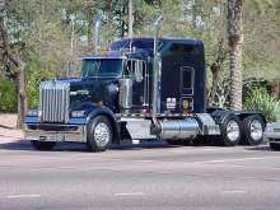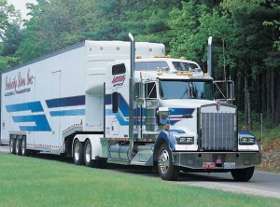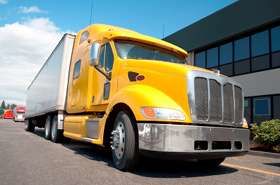First Winter!
Topic 16776 | Page 1
Hi, Carlos. You listed some decent "rules" for icy driving. I wrote a post called "sleigh ride" about driving on icy roads. Use the search box above and look for that term. The basic idea is to not use any braking if you suspect ice might be on the roads. That means driving real slow.
Here's a few comments listed by your numbers:
1. Sure cold night air might mean ice. But did you realize that warmer daytime temps means wet ice? That's more dangerous.
2. "Don't worry ... the roads are pre-treated." Sure they are. And your brother will be paying you back that $50 he owes you next week, too! Don't trust that rule. Drive for ice, and you get a good surprise if the salt's been laid down.
3 + 4. The thing about icy bridges is true. Bridges get iced up way before regular roads. As you approach, slow down (coast, no brakes), and aim for a point on the other side. Try not to change direction or touch the brakes until you get over the bridge. Use the accelerator lightly or not at all. 5. Jakes/ engine retarders only work to slow the drive axle - the wheels in the middle of your rig. Yes, that's an invitation to jackknife.
6. Retarder systems usually have three levels on the switch, and yes, it uses a certain number of cylinders to adjust the stopping power.
7. Driving before or àpres snow? I figure fresh snow will have better traction than packed snow, all things being equal. You should be more concerned about driving visibility.
8. This sounds like driver lounge talk. It also contradicts your #7.
9. Your truck has a dashboard thermometer that reports outside air temperature. You'll see a warning signal come up at 34°. See your #1.
10. Don't know about that. Maybe you won't run into that wet ice as in #1?
Extra suggestion: before it gets too cold, stop at a Walmart in the northern states to get a good cold weather work jacket and gloves, etc. Texas stores won't carry the real cold weather gear.

Excellent input, Errol! I appreciate it. It's true about the cold gear down here... Trainer and I stopped at many stores in northern states and I noticed things for sale I don't see in stex (sleeping bags, trapper hats, thise big gloves with only thumb finger i dont even know what theyre called)

Carlos, first off I wish you well and say that Errol as usual has some very sound advise. While I'm not a trucker I have been driving for 43 years in New England. I live in NH and I like driving in the winter. That helped because for 15 years I was also driving a police cruiser besides my POV (personally owned vehicle) because many times I didn't have a choice, I had to go out to the scene of an accident or fire. I was also on my local fire department and and EMT with my local Recue Squad. Going out in the bad stuff was a regular thing. There are so so many tips and bits of advise that could be shelled out about winter driving that I don't have time to address. Some of the items you might hear from people that seem contradictory really might not be. The reason being that temperatures and timing will change things from bad to good or good to bad. So in one combination you will want to do one thing but when it changes to a different combination you might need to do something different.
Believe it or not, you will have more traction on snow when it is colder say 5F than when it is 30F. The reason is that the colder it is the dryer the snow is and it either blows off easily or stays put under your tires. Both are good things. When it is warmer especially around the freezing mark, it becomes very wet and slushy and can be very dangerous causing a kind of hydroplaning only worse than in water. Depending on the water content and depth what sometimes happens in a split second is your tire rides up on top of the slush and because of the weight of your truck it squeezes out most of the water and packs the rest of the frozen portion into ice.
Salt on the roads is a common treatment for ice and snow however it doesn't work at really cold temperatures like 10F and below. Some say it doesn't work at all until it is 20F or above. As far as driving goes, it has it's pros and cons based on temperature and how long it has been on the road. The transition from when it is first applied to when the road is clear can be a pain at times. As it starts melting the snow it creates a condition that we often call "greasy" where it is creating that slushy wet condition I mentioned earlier which can be much more hazardous than not treating the road but it will clear up and be much better. Another issue is the salt spray from other vehicles. Not only does it make your truck look terrible but it can make your view out the windshield even worse. Keep your windshield washer fluid filled and carry a bottle with you. Preferably one meant for cold and even freezing temperatures. It can help clear ice from your windshield too.
"Black ice". Now this is the worse case and you need to stay off the road if at all possible. If you can't or one minute it wasn't icy but all of a sudden you hit a section of road that is icy, then stay off the brake and just gently steer through it. You may even need to get on the clutch to disengage the drive wheels even without the jake brake active. There are times like this when the shoulder can be your friend where there may be dirt, gravel or grass. You will at least have one steer tire with improved traction. One way to tell if the road is changing from just being wet to ice is when there is no longer any spray coming up from the wheels of the vehicles around you or your own. If that happens don't use your brakes but SLOW DOWN especially in traffic because you are about to come upon an accident. It may be one that already happened or is starting to happen in front of you.
One last thing. Besides bridges, you will find shady areas more prone to freezing as well. It might be a corner of the road lined with trees that is always in the shade or in hilly mountainous areas such as we have up here where sections of roads are in the shade most of the day during the winter.
I hope none of this scares you because you can do it. Just be careful and take it easy when conditions warrant it. Just because some of us were born and raised in these conditions does not mean we have a different gene that made us any more capable of driving in these conditions. We had to learn just like you can, and will.
Keep safe, keep learning and keep driving.

It's 41 up here today and I doubt we will see anything higher until maybe March. Already had a small snow storm last week, I went fishing in it why not eh.
Welcome to Canada where snow is the normal 5 month's of the year but honestly you just get used to it and it's not that bad.
And you'll learn the different sounds the snow makes and that can tell you a lot. And get some good sun glasses to save your eyes.

Carlos this will be my fourth winter in a semi. I have learned several important aspects of winter driving that will hopefully help you. 1- Increase your following distance. Cannot stress enough how incredibly important this is. If at all possible I try to double my following distance in the snow and wintery mix. I also will drop my speed, especially if I am dead heading. I am highly vigilant to avoid bunching and clustering with traffic and other trucks. Space management IMO is the single most important winter driving discipline there is. If that's the only thing you do...you should be able to keep yourself out of harms way.
2- Allow more time to stop. Plan to stop, take the steps necessary to safely slow the truck down before you actually need to completely stop. Finesse the brake, do not apply too much pressure or stab the brakes. Exercise finesse when accelerating as well. A tractor jackknife is almost impossible to recover, and many times is caused by much throttle in situations of limited traction.
3- SLOW DOWN. Especially important as you learn how your truck responds on a snow covered road.
4- Use windshield washer that contains a de-icing agent. I buy mine by the case at Home Depot. It's usually orange or purple and goes by a variety of brand names. It helps to reduce the build up of ice on and around the wiper blades.
5- When the roads are wet, and the temperature is at or near freezing I frequently check to see if their is a spray coming off the trailer tandems. If there is a constant spray, you are likely not on any ice. Perhaps not entirely fool proof, but this hasn't let me down.
6- If you think you need to chain up, only do so to find a safe place to shut down. Allow it to pass....safety is far more important than your delivery or pick-up time.
7- If I know I am going to be driving on roads that are hilly I will many times run with my differential lock "on". This basically powers all four sets of drive wheels. Just be aware that you must be at a full stopped before switching it on or off.
8- I deliver to Walmarts. I stop at a minimum of three, sometimes 7 times during the course of a 12-14 hour day. I always run the bunk heater to keep moisture on the truck windshield and window glass from refreezing.
9- If you have heated mirrors, use this feature, it works.
10- Dropping an empty trailer. I have seen so many drivers get stuck trying to get out from under an mt. If you have them, DO not dump the air from the air bags. Although I never do this, some drivers tend to dump their air and walk out form under the trailer. In the snow and ice buildup you need the weight of the trailer to assist with traction. Use the differential lock out and over-ride the wheel slip feature. This is usually a button marked as such. On the Cascadias its to the right of the steering column in the row of switches.
11- If snow accumulates on your fifth-wheel. Attempt to clear it before coupling to a trailer. Check that there isn't a significant build-up of ice and slush on your kingpin lock.
There is a significant amount of winter driving information archived from previous forum discussions. Use the search bar in the upper left hand corner to access this information.
Good luck...be safe.
Tandems:
Tandem Axles
A set of axles spaced close together, legally defined as more than 40 and less than 96 inches apart by the USDOT. Drivers tend to refer to the tandem axles on their trailer as just "tandems". You might hear a driver say, "I'm 400 pounds overweight on my tandems", referring to his trailer tandems, not his tractor tandems. Tractor tandems are generally just referred to as "drives" which is short for "drive axles".
Tandem:
Tandem Axles
A set of axles spaced close together, legally defined as more than 40 and less than 96 inches apart by the USDOT. Drivers tend to refer to the tandem axles on their trailer as just "tandems". You might hear a driver say, "I'm 400 pounds overweight on my tandems", referring to his trailer tandems, not his tractor tandems. Tractor tandems are generally just referred to as "drives" which is short for "drive axles".
OWI:
Operating While Intoxicated

Awesome, guys! I have been told that I'm stressing too much over it and it's really not that bad. This makes me a bit more confident. I really appreciate the info! Heading out tomorrow won't be back home till Thanksgiving (hopefully on time)... sure to run into some wintry conditions by then.

With what every one else has said SLOW way down. Increases fallowing distense. I know for a Fact that a fully loaded semi on level ice and snow at 25 mph takes around 300 yards to come to a stop. Been there done that. I have a rule of thumb I always do, the human brain can handle 2 challenge s at once, adding a 3rd and you are to distracted. so if I have 2 problems snow and it's dark that's ok add wind and I am finging someplace to park.
One more thing fallow your gut, if it says don't go or its time to get off the road find someplace to park and wait it out. You would be surprised at how right your self preservation instincts are.
OWI:
Operating While Intoxicated
Murderspolywog suggests:
One more thing fallow your gut,
Be sure the "gut" you're following in the snow is your chicken gut, not the macho cojones, "I can do this!" gut!
OWI:
Operating While Intoxicated
Carlos, I'll be honest with you. . Despite me being out here since February, I'm stressing about it too. I do feel a little better because I now team with a former trainer, however, I also know his expectations will be high, as usual. I don't feel I got enough winter driving experience last February since my company had me primarily in the Southeast.
I'm guessing this apprehension is to be expected and I'm trying not to worry so much about it and will remain to be as vigilant and cautious as normal.. maybe moreso.
New Reply:
New! Check out our help videos for a better understanding of our forum features

















Preview:
This topic has the following tags:
Winter Driving Tips







 TT On Facebook
TT On Facebook
Guys I'm a bit worried. I've lived in south Texas all my life. Honestly, I have never seen snow in my life or experienced weather colder than 35 degrees. Never had a run in with icy roads or bridges. JUst been out of training, driving solo 2 weeks. Winter is around the corner and I'm doing 48 states.
I've been asking around trying to get some insight and there is a lot of conflicting info/opinions. FRom 1. DON'T drive at night/early morning because it's colder and ice more likely to be present 2. DON'T worry about icy roads, they will be pre-treated. 3. Let off throttle on all bridges, don't brake, gas or steer, just let your speed get you across (what about long, curved, ascending bridges??) 4. You CAN gas and steer and brake, just lightly on bridges (what??) 5. NEVER use jake on snowy/icy downgrades. 6. OK to use jake on downgrades just not all cylinders (????) 7. Don't drive when there is snowfall... vs ok to drive after snowing (whats the difderence?) 8. CUt your own path in snow vs drive on pre-cut tracks. (What)
Also... 9. DON'T drive when raining and 34 degrees because rainfall will ice the road quickly (makes sense) 10.Safer to drive in colder weather than 30 degrees.
Im all confused everyone says some different can't decipher the bro science since this is completely new to me... any input??
OWI:
Operating While Intoxicated